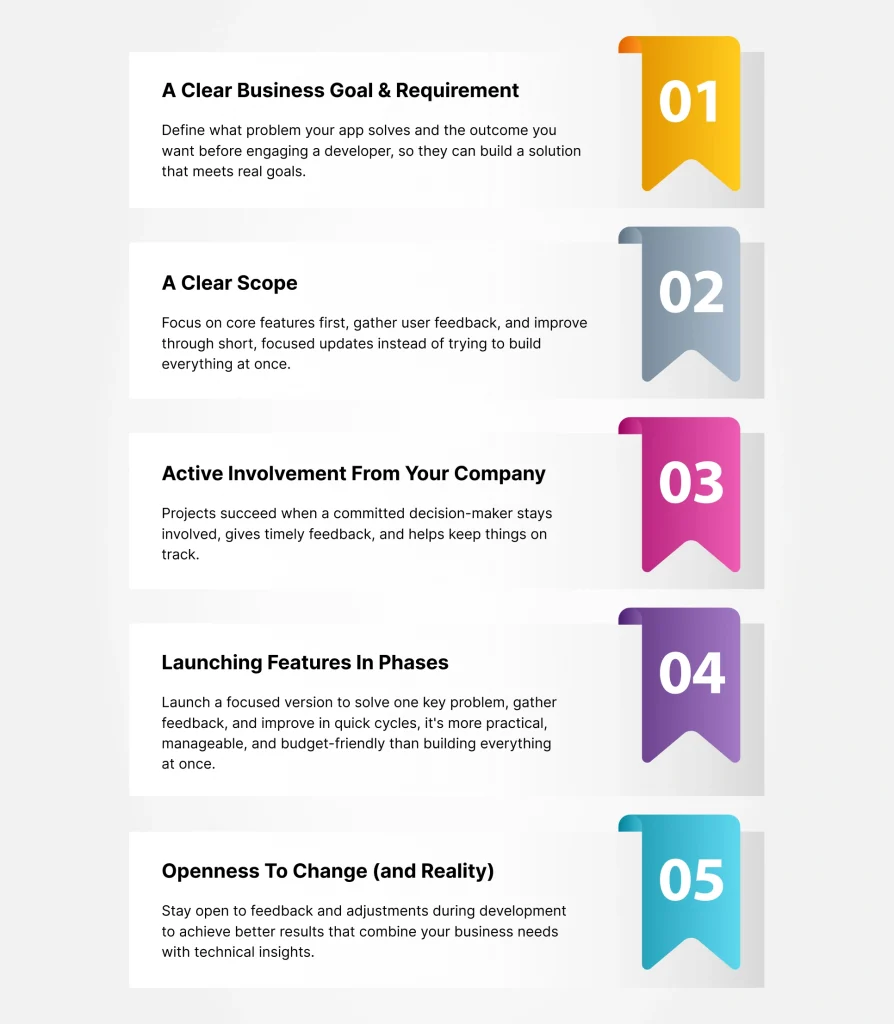What Makes a Software Project Succeed (or Fail)?
Unpopular opinion, but bad code is not the only source of a failed software development project. Projects may have failed because of unclear goals, frequent changes, poor planning, and the wrong mindset.
But, why?

The Common Pitfalls In A Software Project
We have seen companies finding a new software vendor to rebuild or take over their app because it doesn’t address their business requirement, or it may have been full of bugs. But at the same time, we have also seen projects that move smoothly because the clients know what they want in their apps.
Why do some software development projects work while others crash or fail?
Let’s break it down.

1. Unclear Requirement
Some clients only share a rough idea of their project. They skip the important part of the details and expect developers to fill in the blanks.
There are also clients who skip the project brief or discussion entirely.
This can cause confusion and wrong assumptions about project direction and goals, leading to a waste of time and resources.
2. Too Many Features
Some businesses want to include every idea and feature in the first version of the app. Although it sounds efficient to include all the features, this usually backfires.
When everything is set to be released in version 1.0, the scope becomes harder to manage. Priorities get blurred. Developers spend time jumping between disconnected features instead of focusing on one strong use case.
This increases the risk of delays and bugs, leading to a system that doesn’t support your actual goal.
3. Inexperienced Development Team
Some businesses select vendors based on the lowest quotation provided because it feels like a safe move towards their budget. However, not all development teams have the right skills for complex business systems.
A team without experience in similar projects may struggle to understand the needs, structure, and flow required for the project. If the team is mostly made up of junior developers, they might face challenges translating business logic into working solutions.
It is important to look beyond the cost and consider the team’s track record, project understanding, and ability to build what the business truly needs.
4. Unrealistic Timelines
Setting a launch date before truly understanding what your project needs is a big no. You can’t set a deadline on when you want the product to be launched without making the key decisions.
When you want an app to be ready in two months, developers will rush. They then skip proper planning, design, and testing processes. This leads to more bugs that need fixes, which will cost more money and delays in the app.
5. Unrealistic Budget
Some projects run into problems because the budget doesn’t match the actual scope of work. When the budget is too tight, developers might skip planning, design and testing processes as mentioned for unrealistic timelines.
But, in some cases, the project may be handed to a team or freelancers that lack the experience to handle complex business needs, simply because they need to fit the price range.
This affects quality, slows progress, and increases the risk of rework. What starts as a cost-saving measure can end up costing more in the long run.
While a quotation is a contributing factor, it shouldn’t be the final decision-maker. That’s why choosing vendors only based on the quotation may cause software development projects to fail.
So, What Makes A Project Work?
Projects fall apart when development is rushed without really knowing what they need.
On the other hand, a project moves smoothly and succeeds when clients understand that an app should work to support their business growth, and not just function.
Here’s what we have seen in projects that succeed:
1. A Clear Business Goal and Requirement
It is advisable to run an internal round of discussion before you approach a software development company. Draft and early version of your requirements. This gives the developers a starting point and helps them to guide you in shaping a solution.
“We want an app” isn’t a goal. Knowing what the app can solve and the result you expect is the goal. The clearer your outcome, the better the development team can design around it.
2. A Clear Scope
Successful clients know the difference between a must-have and a nice-to-have. They focus on solving key problems and release and learn based on usage data and user feedback to improve or expand in the next phase.
It’s better to launch with a focused version that solves one key problem at a time. From there, you can gather data on how users interact with it and their feedback. Then, release updates in short, frequent cycles.
This keeps the solution practical, manageable, and easier to improve compared to building one big version that tries to cover everything. This also makes a better use of your budget.
3. Active Involvement From Your Company
The most successful project happens because of a decision-maker who shows up at the right time. They give fast feedback, ask the right questions, and keep things aligned from start to end.
That also includes confirming user flows before development starts. It could mean replying within the day when something needs clarification. Or showing up in weekly check-ins to approve progress and unblock decisions.
This keeps both your team and your vendor aligned. It helps avoid miscommunication, especially around features, priorities, and timelines. You will also have a better chance of getting a result that meets your expectations.
4. Launching Features In Phases
It’s better to launch with a focused version that solves one key problem at a time. From there, you can gather data on how users interact with it and their feedback. Then, release updates in short, frequent cycles.
This keeps the solution practical, manageable, and easier to improve compared to building one big version that tries to cover everything. This also makes a better use of your budget.
5. Openness To Change (and Reality)
Projects work better when businesses stay open to feedback and technical reality. Plans will shift during development. Priorities might change. That’s normal. What matters is how both sides respond when it happens.
Businesses usually bring deep operational knowledge. They know how their processes work and what their teams need. Developers, on the other hand, bring insights from different industries and technical experience.
The best results come when both sides are open to each other’s input and willing to adjust the plan if it leads to a better outcome.
Software development is not about building fast but doing it right.

Conclusion
Being more prepared and aligned from day one as a business owner gets you a better chance of building something that will grow your company.
Have a clear checklist of what your project needs and look for the right vendor who can turn that vision into a digital solution with clarity, structure, and experience.


